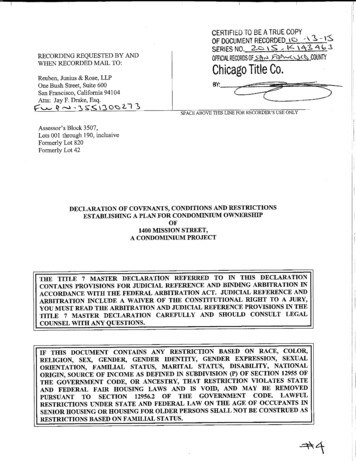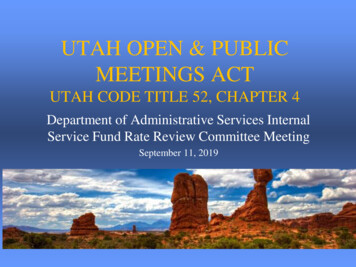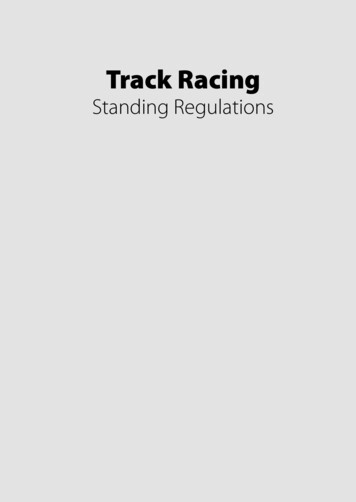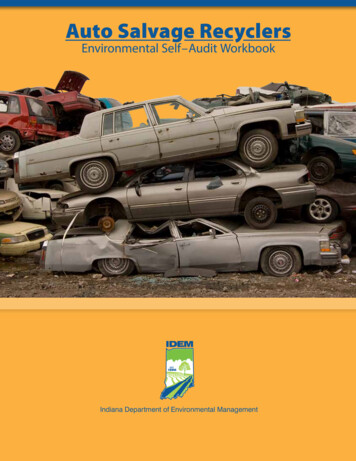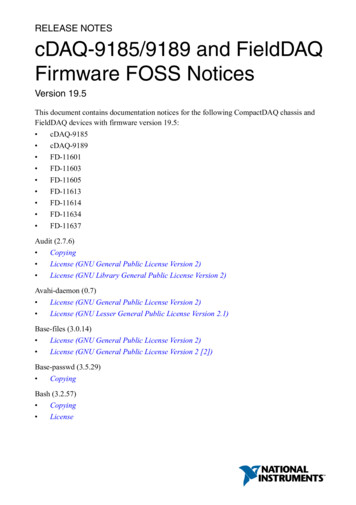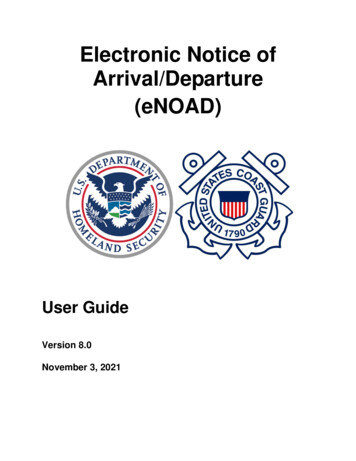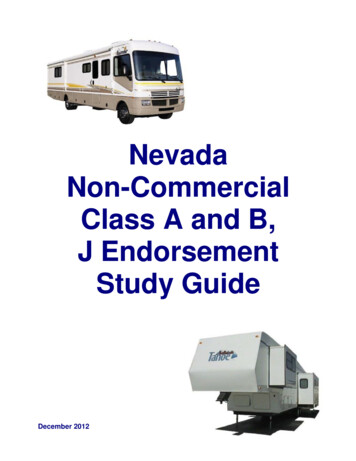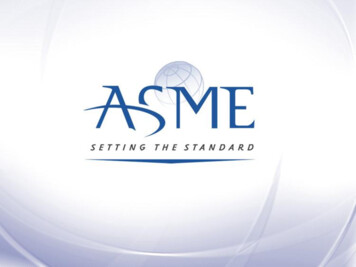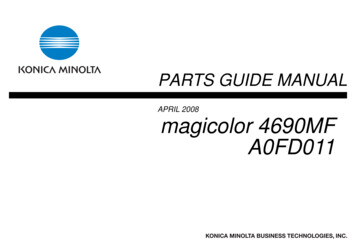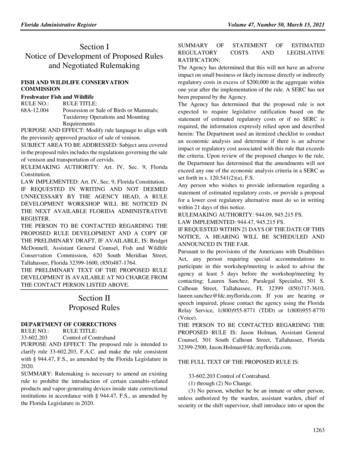
Transcription
Florida Administrative RegisterSection INotice of Development of Proposed Rulesand Negotiated RulemakingFISH AND WILDLIFE CONSERVATIONCOMMISSIONFreshwater Fish and WildlifeRULE NO.:RULE TITLE:68A-12.004Possession or Sale of Birds or Mammals;Taxidermy Operations and MountingRequirementsPURPOSE AND EFFECT: Modify rule language to align withthe previously approved practice of sale of venison.SUBJECT AREA TO BE ADDRESSED: Subject area coveredin the proposed rules includes the regulations governing the saleof venison and transportation of cervids.RULEMAKING AUTHORITY: Art. IV, Sec. 9, FloridaConstitution.LAW IMPLEMENTED: Art. IV, Sec. 9, Florida Constitution.IF REQUESTED IN WRITING AND NOT DEEMEDUNNECESSARY BY THE AGENCY HEAD, A RULEDEVELOPMENT WORKSHOP WILL BE NOTICED INTHE NEXT AVAILABLE FLORIDA ADMINISTRATIVEREGISTER.THE PERSON TO BE CONTACTED REGARDING THEPROPOSED RULE DEVELOPMENT AND A COPY OFTHE PRELIMINARY DRAFT, IF AVAILABLE, IS: BridgetMcDonnell, Assistant General Counsel, Fish and WildlifeConservation Commission, 620 South Meridian Street,Tallahassee, Florida 32399-1600, (850)487-1764.THE PRELIMINARY TEXT OF THE PROPOSED RULEDEVELOPMENT IS AVAILABLE AT NO CHARGE FROMTHE CONTACT PERSON LISTED ABOVE.Section IIProposed RulesDEPARTMENT OF CORRECTIONSRULE NO.:RULE TITLE:33-602.203Control of ContrabandPURPOSE AND EFFECT: The proposed rule is intended toclarify rule 33-602.203, F.A.C. and make the rule consistentwith § 944.47, F.S., as amended by the Florida Legislature in2020.SUMMARY: Rulemaking is necessary to amend an existingrule to prohibit the introduction of certain cannabis-relatedproducts and vapor-generating devices inside state correctionalinstitutions in accordance with § 944.47, F.S., as amended bythe Florida Legislature in 2020.Volume 47, Number 50, March 15, 2021SUMMARY OF STATEMENT OF :The Agency has determined that this will not have an adverseimpact on small business or likely increase directly or indirectlyregulatory costs in excess of 200,000 in the aggregate withinone year after the implementation of the rule. A SERC has notbeen prepared by the Agency.The Agency has determined that the proposed rule is notexpected to require legislative ratification based on thestatement of estimated regulatory costs or if no SERC isrequired, the information expressly relied upon and describedherein: The Department used an itemized checklist to conductan economic analysis and determine if there is an adverseimpact or regulatory cost associated with this rule that exceedsthe criteria. Upon review of the proposed changes to the rule,the Department has determined that the amendments will notexceed any one of the economic analysis criteria in a SERC asset forth in s. 120.541(2)(a), F.S.Any person who wishes to provide information regarding astatement of estimated regulatory costs, or provide a proposalfor a lower cost regulatory alternative must do so in writingwithin 21 days of this notice.RULEMAKING AUTHORITY: 944.09, 945.215 FS.LAW IMPLEMENTED: 944.47, 945.215 FS.IF REQUESTED WITHIN 21 DAYS OF THE DATE OF THISNOTICE, A HEARING WILL BE SCHEDULED ANDANNOUNCED IN THE FAR.Pursuant to the provisions of the Americans with DisabilitiesAct, any person requiring special accommodations toparticipate in this workshop/meeting is asked to advise theagency at least 5 days before the workshop/meeting bycontacting: Lauren Sanchez, Paralegal Specialist, 501 S.Calhoun Street, Tallahassee, FL 32399 (850)717-3610,lauren.sanchez@fdc.myflorida.com. If you are hearing orspeech impaired, please contact the agency using the FloridaRelay Service, 1(800)955-8771 (TDD) or 1(800)955-8770(Voice).THE PERSON TO BE CONTACTED REGARDING THEPROPOSED RULE IS: Jason Holman, Assistant GeneralCounsel, 501 South Calhoun Street, Tallahassee, Florida32399-2500, Jason.Holman@fdc.myflorida.com.THE FULL TEXT OF THE PROPOSED RULE IS:33-602.203 Control of Contraband.(1) through (2) No Change.(3) No person, whether he be an inmate or other person,unless authorized by the warden, assistant warden, chief ofsecurity or the shift supervisor, shall introduce into or upon the1263
Florida Administrative Registergrounds of an institution any of the following articles which arehereby declared to be contraband:(a) through (e) No Change.(f) Any other article, instrument, or substance specificallyprohibited by the policies and rules of the institution or declaredto be contraband pursuant to Section 947.47, F.S.(4) through (9) No Change.Rulemaking Authority 944.09, 945.215 FS. Law Implemented 944.47,945.215 FS. History–New 10-8-76, Amended 2-24-81, 4-18-82, 8-1384, 2-13-85, 6-2-85, Formerly 33-3.06, Amended 2-9-87, 11-3-87, 814-90, 11-21-91, 1-6-94, 5-28-96, 10-26-97, Formerly 33-3.006,Amended 3-2-00, 7-8-03, 11-10-03, 6-28-07, 11-28-11, 12-5-12, 4-2213, 11-4-13, 1-7-14, .NAME OF PERSON ORIGINATING PROPOSED RULE:Richard Comerford, Assistant Deputy Secretary of InstitutionsNAME OF AGENCY HEAD WHO APPROVED THEPROPOSED RULE: Mark S. Inch, SecretaryDATE PROPOSED RULE APPROVED BY AGENCYHEAD: March 04, 2021DATE NOTICE OF PROPOSED RULE DEVELOPMENTPUBLISHED IN FAR: October 27, 2020Section IIINotice of Changes, Corrections andWithdrawalsDEPARTMENT OF HEALTHBoard of NursingRULE NO.:RULE TITLE:64B9-14.0015 Delegated TasksNOTICE OF CHANGENotice is hereby given that the following changes have beenmade to the proposed rule in accordance with subparagraph120.54(3)(d)1., F.S., published in Vol. 46 No. 244, December17, 2020 issue of the Florida Administrative Register.The change is in response to written comments submitted by thestaff of the Joint Administrative Procedures Committee anddiscussion and subsequent vote by the Board at the publictelephonic meeting held February 5, 2021. The rule shall nowread as follows:64B9-14.0015 Delegated Tasks.(1) No change.(2) A registered nurse may delegate administration ofmedications by a CNA or HHA that meets the requirements ofs. 464.2035, and s. 400.489, F.S., to a patient of a home healthagency.(3) (2) No change.Rulemaking Authority 400.489, 464.2035(3), 464.0156(3) FS. LawsImplemented 464.0156, 464.2035 FS. History–New .1264Volume 47, Number 50, March 15, 2021THE PERSON TO BE CONTACTED REGARDING THEPROPOSED RULE IS: Joe Baker, Jr., Executive Director,Board of Nursing, 4052 Bald Cypress Way, Bin ealth.gov.FISH AND WILDLIFE CONSERVATIONCOMMISSIONRULE NO.:RULE TITLE:68-5.007Possession of Prohibited Non-NativeSpeciesNOTICE OF CHANGENotice is hereby given that the following changes have beenmade to the proposed rule in accordance with subparagraph120.54(3)(d)1., F.S., published in Vol. 46 No. 179, September14, 2020 issue of the Florida Administrative Register.68-5.007 Possession of Prohibited Non-native Species.No person shall import into the state, sell, possess, or transportany live specimens of the species, or hybrids or eggs ional/Prohibited/Nonnative Species permit and asprovided below:(1) Exhibition of Prohibited Species:(a) Eligibility:1. A permit for educational exhibition of Prohibited speciesshall only be issued to public aquaria, zoological parks, orpublic exhibitors.2. If a person, firm, or corporation held a valid captivewildlife class III exhibition or sale license on June 30, 2020, anddocumented an inventory of green iguanas or tegus on his orher or its 2018 or 2019 license application or indicated plannedpossession of green iguanas or tegus on his or her or its 2018 or2019 license application, the Commission, upon receipt of acompleted permit application, shall authorize that person, firm,or corporation to continue to exhibit green iguanas or tegulizards for as long as the person, firm, or corporation maintainsan active permit.a. Such status is void upon any permit transfer or lapse.b. The person, firm, or corporation may not import greeniguanas or tegus into this state.c. Public exhibitors without a facility that is open to thepublic during normal business hours must show proof of aminimum of 12 educational engagements equating to aminimum of 48 hours of public exhibit contact time annually.This proof shall be available for inspection at all times and mustinclude venue, venue address, date of exhibit, exhibit times,number of public participants and advertisement or invitationinformation.3. Permits shall not be issued to entities operating atresidential properties private residences, except that:
Florida Administrative Registera. The Commission may authorize applicants or permitteesthat qualify for a permit under subparagraph 68-5.007(1)(a)2.,to operate at a residential property.b. If a person, firm or corporation held a valid captivewildlife license to exhibit Burmese pythons, reticulatedpythons, Northern African pythons, Southern African pythons,scrub pythons, amethystine pythons, green anacondas, or Nilemonitors prior to these species becoming listed as Prohibitedand documented the species in their inventory on their 2019 or2020 captive wildlife license application, the Commission mayauthorize that person, firm or corporation to continue to operateat a residential property. Public exhibitors must show proof ofa minimum of 12 educational engagements equating to aminimum of 48 hours of public exhibit contact time annually.This proof shall be available for inspection at all times and mustinclude venue, venue address, date of exhibit, exhibit times,number of public participants and advertisement or invitationinformation.c. Only individual animals possessed by the applicant orpermittee prior to the species’ listing as Prohibited maycontinue to be possessed under this exception. No additionalspecimens of those species may be acquired under thisexception.(b) through (d) No change.(2) Research: Individuals or institutions engaged inresearch shall be granted a permit, provided the followingrequirements are met:(a) Eligibility: The Commission may issue permitsauthorizing possession of Prohibited species for scientific orconservation purposes which will benefit the eradication andcontrol potential of the species. For the purposes of this rule, ascientific or conservation purpose shall mean activities thatfurther the understanding of the biology of the species, impactsthe species may have on Florida’s ecology, economy, or humanhealth and safety, and collection of scientific data needed forcontrol and management of the species. The following factorsshall be considered in determining whether there is a scientificor conservation purpose: A permit for research involvingProhibited species shall be issued only to a principalinvestigator who is a faculty member of a college or university,is affiliated with an accredited institution, or is a member of afederal, state, county, or tribal agency.1. Whether the purpose for which the permit is requiredjustifies the risk of maintaining the species;2. Whether the permit would conflict with any programintended to enhance survival of native species;3. Whether the purpose of the permit would likely reducethe presence of nonnative species in the wild;4. Whether the probable direct or indirect effects on nativewildlife, habitat, and the economy posed by issuing the permitare justified by the benefits of the research;Volume 47, Number 50, March 15, 20215. The opinions or views of scientists or other persons ororganizations having expertise concerning the species sought tobe possessed or planned research methodology; and6. Whether the expertise, facilities, or other resourcesavailable to the applicant are adequate to successfullyaccomplish the objective stated in the application.(b) through (e) No change.(3) Eradication and Control(a) No change.(b) Permits for eradication and control projects involvingthe release of Prohibited species for telemetry projects1. Eligibility: Permits shall only be issued to a principalinvestigator who is a faculty member of a college or university,is affiliated with an Association of Zoos and Aquariums orZoological Association of America accredited institution, or isa member of a federal, state, county, or tribal agency.2. No change.(c) All animals removed under a permit for eradication andcontrol shall be humanely killed.,except Ggreen iguanas andtegus removed by persons in possession of a valid commercialuse of green iguanas and tegus permit pursuant to subsection(4) below shall be maintained by the permittee for commercialsale under the provisions of that permit, transferred to otherentities permitted under subsection (4) below, or humanelykilled.(d) All Prohibited species eggs encountered duringpermitted eradication and control activities shall be destroyedin place and shall not be removed intact from the nest location.(e) The permit will expire 12 months from the date ofissuance.(4) Commercial Sales Use of Green Iguanas (Iguanaiguana) and Tegus (genera Salvator and Tupinambis, allspecies):(a) If a person, firm, or corporation held a valid captivewildlife class III exhibition or sale license on June 30January 1,2020, and documented an inventory of green iguanas or teguslizards on his or her or its 2018 or 2019 license application orindicated planned possession of green iguanas or tegus on hisor her or its 2018 or 2019 license application, the Commission,upon receipt of a completed permit application, shall mayauthorize that person, firm, or corporation so as to allow themto continue to exhibit, sell, or breed green iguanas or tegulizards commercially for as long as the person, firm, orcorporation maintains an active permit the license remainsactive.1. Such status is void upon any permit license transfer orlapse.2. The person, firm, or corporation may only sell suchinventory outside of this state and may not import green iguanasor tegus the species into this state.1265
Florida Administrative Register3. Such entities may only continue to breed green iguanasor tegus until June 30, 2024. After that date, no additionalbreeding of green iguanas or tegus will be authorized. Malesand females shall be caged separately after that date. Proof ofsex for each individual shall be made available upon request byCommission personnel. Any eggs produced after June 30, 2024shall be destroyed immediately.(b) Applicants for permits to possess green iguanas or tegusfor commercial sales use purposes in accordance with ited/Nonnative Species Permit applicationform FWC WIM 05 (12/20)[Form Number] available athttps://www.flrules.org/Gateway/reference.asp?No Ref12804 [hyperlink] which is adopted and incorporated herein byreference. Forms may also be obtained by submitting a requestto: Florida Fish and Wildlife Conservation Commission,Division of Habitat and Species Conservation, 620 SouthMeridian Street, Tallahassee, Florida 32399-1600.(c) Permitted commercial sales users shall submit anannual report at the conclusion of each license period detailingthe following:1. The seller name, seller license number, source of eachanimal, recipient name, recipient location, species commonname, species scientific name, date of sale or transfer, andquantity sold for each sale or transfer.2. Reports shall be submitted by email toNonnativePermitApps@MyFWC.com or by mail to the FloridaFish and Wildlife Conservation Commission, Division ofHabitat and Species Conservation, Wildlife ImpactManagement Section, 620 South Meridian Street, Tallahassee,Florida 32399-1600, within 90 days of permit expiration orupon application for permit renewal, whichever is precedent.(d) The permit will expire 12 months from the date ofissuance.(5) Personal Possession of Prohibited Species:(a) Eligibility:1. Reptiles of Concern: persons with a valid license topossess Reptiles of Concern for personal use may continue topossess those animals in accordance with the provisions of thatlicense and Chapter 68A-6, F.A.C. Prohibited reptile speciesshall only be permitted to be possessed for personal use inaccordance with section 379.372, F.S.2. Other Prohibited species: if the Commission designatesa species as a Prohibited species after May 2, 2019, theCommission may authorize the personal possession of thatnewly designated species by those licensed or otherwiseauthorized to possess that species before the effective date ofthe species’ designation by the Commission as a Prohibitedspecies.3. Permits may only be granted to persons in lawfulpossession of such species prior to the species’ listing as1266Volume 47, Number 50, March 15, 2021Prohibited for the remainder of the life of the animal. Noadditional specimens individuals may be acquired. If the animalremains alive following the death or dissolution of the licensee,the animal may be legally transferred to another entity holdinga permit authorizing possession of the same species animal forthe remainder of the life of the animal.4. Identification: Prohibited species possessed for personaluse shall be permanently identified with a unique passiveintegrated transponder (PIT tag). Identification shall consist ofthe implantation of a unique PIT tag under the specimen’s skinin a manner to maintain the PIT tag permanently in place.(b) Permit qualifications:1. Applicants for permits to possess Prohibited species forpersonal use in accordance with this section shall submit acompleted Conditional/Prohibited/Nonnative Species Permitapplication form WIM 01 (02/19) available athttps://www.flrules.org/Gateway/reference.asp?No Ref10435 which is adopted and incorporated herein by reference.Forms may also be obtained by submitting a request to: FloridaFish and Wildlife Conservation Commission, Division ofHabitat and Species Conservation, 620 South Meridian Street,Tallahassee, Florida 32399-1600.2. Records of identification including PIT tag numberwhere applicable, along with information about the specimenbeing identified (species, specimen name or number, sex, andage) must be provided to the Commission upon permitapplication.(c) The permit will expire 12 months from the date ofissuance.(6) Inspections Caging and Biosecurity(a)Inspections:1. Permittees and applicants applying topossess captive Prohibited species may shall be inspected byCommission personnel or an authorized representative of theCommission prior to issuance of a permit. Scheduled andunannounced inspections to ensure general security measuresare followed may be conducted at any time during the permitand/or application period. Commission personnel shalldetermine whether the Prohibited species are securely, properlyand safely housed. In the event that any Prohibited species arenot securely, properly and safely housed, Commissionpersonnel shall report the situation in writing to the personauthorized to possess or exhibit such Prohibited species. Failureof the possessor or exhibitor to correct the situation within 30days after such written notice shall be grounds for revocation ofthe permit.(b) 2. Refusal of inspection shall result in denial of permitapplication or revocation of existing permit.(b) Prohibited species maintained for exhibition purposesshall only be exhibited from within approved enclosures.Prohibited species shall not be exhibited in any mobileexhibitions.
Florida Administrative Register(7) Caging and Biosecurity(a)(c) Prohibited aquatic species shall be maintained inindoor facilities in containers or other confinement facilitiesdesigned to prevent escape and having no exterior waterdischarge or having a water discharge through a closed drainsystem that terminates in a dry-bed wastewater retention areawith no public access.(b)(d) Captive Prohibited terrestrial species shall bemaintained in facilities in cages or other confinement facilitiesthat prevent escape and public contact, except as follows:1. Prohibited reptile species used for mobile exhibitionoutdoors shall be exhibited from within locked enclosures andshall not be free-handled or have public contact.2. Prohibited reptile species used for mobile exhibitionindoors may be exhibited from within locked enclosures or freehandled by the exhibitor or an employee handler. For thepurposes of this section, free- handling is defined as a situationin which an exhibitor or employee handler maintains control,possession, and supervision of the animal with no publiccontact. For the purposes of this section, indoors is defined asinside a room or building where all windows and doors areclosed to prevent escape to the outdoor environment; indoorsdoes not include tents or other non-permanent structures.(c)(e)Captive Prohibited reptile species shall be maintainedin indoor facilities in safe, locked secure, and proper housing incases, cages, or enclosures of the following specifications:1. Enclosures kept indoors shall be structurally sound andconstructed using the following authorized materials: plateglass of at least one-eighth (1/8) inch thickness, break-resistantor injection molded plastic of similar strength, concretereinforced with wire, sheet metal, one-quarter (1/4) inch orsmaller woven or welded wire mesh (hardware cloth), moldedfiberglass, plywood or solid wood (excluding materialsconstructed of lumber by-products such as oriented strandboard (OSB), medium density fiberboard (MDF) andmelamine) that has been treated to be impervious to moistureand is not less than one-half (1/2) inch in thickness, or othermaterials which provide equivalent stability and securityagainst escape and unauthorized intrusion. Materialsconstructed of lumber by-products such as oriented strandboard (OSB), medium density fiberboard (MDF) and melamineshall not be used for indoor enclosures. Enclosures equippedwith tracks holding sliding panels shall have the tracks securedwith screws or rivets and enclosure design shall be escape-prooffor the species contained therein. Enclosures and doors toenclosures shall be locked secured. The doors of each enclosureshall be securely locked by a device operated by a key,combination lock, key card or other locking device approved bythe Commission to prevent unauthorized intrusion.Volume 47, Number 50, March 15, 20212. A room or outbuilding may contain indoor Prohibitedreptile species enclosures, provided that such a room oroutbuilding is equipped with a safety entrance as described insubparagraph 68-5.007(7)(c)3. below and locked by a deviceoperated by a key, combination lock, key card, or other lockingdevice approved by the Commission to prevent unauthorizedintrusion, is inaccessible to unauthorized personnel, isconstructed and maintained as to be escape-proof, and has beeninspected and approved as conforming to these rules byCommission personnel prior to use. If a viewing panel is usedas a portion of an exterior wall, such panel shall be constructedof a minimum of one-quarter (1/4) inch thick, tempered, safetyglass. Viewing panel shall not serve as an access point.3. Outdoor enclosures shall be topped with a close-meshedwire or equivalent barrier, 2. Enclosures shall be equipped witha double doored safety entrance. For the purposes of this rule, asafety entrance is defined as a protected, escape-proof area thatcan be entered by a keeper and prevents escape of Prohibitedreptiles from secondary containment. Lumber Any componentsconstructed of lumber byproducts such as oriented strand board(OSB), medium density fiberboard (MDF), and melamine shallnot be used for outdoor enclosures. Outdoor enclosures shall beinspected and approved as conforming to these rules byCommission personnel prior to use be no less than one-half(1/2) inch in thickness, shall not be directly exposed to weatherand shall be constructed, covered, coated or treated to beimpervious to moisture.3. A room may contain Prohibited reptile species in cagesthat are not locked provided that such a room is equipped witha safety entrance as described in subparagraph 68-5.007(5)(e)2.above and locked by a device operated by a key, combinationlock, key card or other locking device approved by theCommission to prevent unauthorized intrusion, is inaccessibleto unauthorized personnel, is constructed and maintained as tobe escape-proof, and has been inspected and approved asconforming to these rules by Commission personnel prior touse.a. Prohibited reptile species shall not be bred in outdoorenclosures. No clutches shall be laid or maintained in outdoorenclosures and no births shall occur in outdoor enclosures. Nojuveniles shall be reared in outdoor enclosures unless theindividual animal has been marked with a unique PIT tag, inaccordance with paragraph 68-5.007(7)(f), below.b. Prohibited reptile species shall not be maintained inoutdoor enclosures unless the individual animal has beenmarked with a unique PIT tag, in accordance with paragraph68-5.007(7)(f), below.c. The floors of outdoor enclosures shall be of concrete ormasonry block construction at least two (2) inches in thickness.Sides shall be constructed of concrete at least eight (8) inches1267
Florida Administrative Registerin thickness, with a minimum height of four (4) feet above thefloor of the enclosure.d. The corners of outdoor enclosures shall be designed orguarded to prevent the escape of reptiles by climbing.e. All landscaping of outdoor enclosures shall be arrangedto ensure that vegetation or other structures do not allow for theescape of reptiles.f. All outdoor enclosures shall be equipped with shelterwhich is continuously available and sufficient to cover the bodymass of all animals housed within such enclosure.g. If a viewing panel is used as a portion of an exterior wallof an outdoor enclosure, such panel shall be constructed of aminimum of one-quarter (1/4) inch thick, tempered, safetyglass. Viewing panel shall not serve as an access point.h. Facilities with outdoor enclosures housing Prohibitedreptiles shall have 180 days from the date the species is listedas Prohibited to bring such enclosures into compliance with therequirements listed in subsubparagraphs 68-5.007(7)(c)3.a.-g.above.4. Each enclosure housing Prohibited reptiles shall beaccurately, visibly and clearly marked with a label stating“Prohibited Reptile;” identifying the species contained thereinby common and scientific name; and displaying the PIT tagnumber of the specimen(s) within, if applicable. A label asdescribed above shall accompany the Prohibited reptile when itis removed from the enclosure. Prohibited reptile identificationlabels shall be removed from empty enclosures.5. All enclosures shall meet the minimum standard cagingsize requirements as specified in Rule 68A-6.01214, F.A.C.(d)(f) Facilities with one or more permittee at the samefacility location may not commingle their respective liveProhibited species inventories. All cages or enclosures must beclearly identified or visibly marked with the name of thepermittee or other identifier to facilitate inventory inspections.(e)(g)All permittees shall develop a safe handling protocolestablishing requirements for all caretakers to follow regardingbiosecurity and safety. All individuals associated with a facilityauthorized to possess Prohibited reptile species that may be incontact with or provide care for such Prohibited reptile speciesshall demonstrate knowledge of facility requirements andsecure handling protocols for Prohibited species as establishedby the permittee.(f)(h) Identification: Prohibited reptile species shall bepermanently identified with a unique passive integratedtransponder (PIT tag). Identification shall consist of theimplantation of a unique PIT tag under the specimen’s skin in amanner to maintain the PIT tag permanently in place.1. For snakes, implantation shall be in the rear one-third(1/3) of the snake, forward of the anal plate. All snakes over ½inch diameter must be PIT tagged. Any snake not meeting this1268Volume 47, Number 50, March 15, 2021size requirement must be housed indoors until it is PIT taggedand reported to the FWC.2. For lizards, implantation shall be in the body cavity inclose proximity to and forward of a rear leg, or in a rear leg. Alllizards over 5 inches snout-to-vent length (SVL) must be PITtagged. Any lizard not meeting this size requirement must behoused indoors until it is PIT Tagged and reported to the FWC.3. The requirement pertaining to the location of the PIT tagimplantation shall not apply to specimens implanted prior toacquisition of the animal or prior to the effective date of thisrule.4. Records of identification including PIT tag numberwhere applicable, along with information about the specimenbeing identified (species, PIT tag number, sex gender, and age)must be provided to the Commission within 7 days 72 hours ofacquisition and maintained in the possessor’s records for aslong as the specimen is possessed. Such reports shall besubmitted by email to NonnativePermitApps@MyFWC.com orby mail to the Wildlife Impact Management Section, 620 SouthMeridian Street, Tallahassee, Florida 32399-1600.5. Persons with a permit to sell green iguanas or tegus inaccordance with subsection (4) above shall mark all greeniguanas or tegus with a unique PIT tag prior to sale.(g) (i) Transporting:1. Prohibited reptile species shall be transported only afterplacement in a closely woven, double-seam sewn, cloth sack.This cloth sack shall be placed in a second cloth sack of similarconstruction, which shall be placed in a secure, lockedcontainer. Said containers shall be prominently labeled“Prohibited Dangerous Reptiles.”2. Placeholder for transport requirements for other taxagroups.(8) (7) Record Keeping and Reporting(a) Record Keeping: Persons possessing Prohibited speciesshall maintain an accurate record of all changes in inventoryincluding births, deaths, acquisitions, sales and transfers of allProhibited species. Such records shall be kept on the permittedpremises on a Prohibited Species Inventory Report Form FWCWIM 06 (12/20)(form number), available athttps://www.flrules.org/Gateway/reference.asp?No Ref12805 (hyperlink) which is adopted and incorporated herein byreference. Forms may a
Florida Administrative Register Volume 47, Number 50, March 15, 2021 1263 . contacting: Lauren Sanchez, Paralegal Specialist, 501 S. Calhoun Street, Tallahassee, FL 32399 (850)717-3610, lauren.sanchez@fdc.myflorida.com. . Board of Nursing wildlife class III exhibition or sale license on June 30, 2020, and RULE NO.: RULE TITLE: 64B9-14.0015 .

